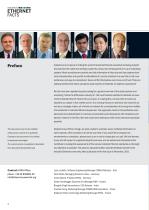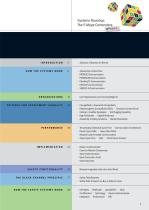
Catalog excerpts

SYSTEM COMPARISON The 5 Major Technologies nd E d i t i o n 2 PROFINET, POWERLINK, EtherNet/IP, EtherCAT, SERCOS III How the Systems Work The User Organizations A Look behind the Scenes Investment Viability and Performance Everything You Need to Know! Safety protocols Learn the basics!
Open the catalog to page 1
Stéphane Potier Huazhen Song Bhagath Singh Karunakaran Stefan Schönegger Anton Meindl Peter Wratil Luca Lachello Outsiders are not alone in nding the world of Industrial Ethernet somewhat confusing. Experts who examine the matter are similarly puzzled by a broad and intransparent line-up of competing systems. Most manufacturers provide very little information of that rare sort that captures technical characteristics and specic functionalities of a certain standard in a way that is both comprehensive and easy to comprehend. Users will nd themselves even more out of luck if they are seeking...
Open the catalog to page 2
Systems Roundup: The 5 Major Contenders nders 2nd Edition · Selection of Systems for Review · User Organizations and Licensing Regimes CRITERIA FOR INVESTMENT VIABILITY Compatibility / Downward Compatibility Electromagnetic Compatibility (EMC) · Electrical Contact Points Cabling / Feasible Topologies · Hot Plugging Capability High Availability · Gigabit Readiness Availability of Safety Solutions · Market Penetration Theoretically Achievable Cycle Time · Communication Architecture Direct Cross-Trafc · Heavy Data Trafc Network Load for Safety Communication Actual Cycle Time · Jitter ·...
Open the catalog to page 3
Selection of Systems for Review | This issue of Industrial Ethernet Facts compares PROFINET (RT, IRT), POWERLINK, EtherNet/IP, EtherCAT, and SERCOS III, i.e. ve out of about 30 Industrial Ethernet systems currently in use around the world.1 Why these ve? The selection was based on technical aspects, standardization status, and strategic market considerations. Relevant issues include e.g. whether a user organization backs the ongoing development of a protocol, whether a protocol is classied in the IEC standard, and whether a system is suitable for hard real-time requirements. Real-time A...
Open the catalog to page 4
Systems Roundup: The 5 Major Contenders nders 2nd Edition Market Penetration Another key aspect in selecting Industrial Ethernet systems for comparison was market penetration: various IMS and ARC surveys indicate that about three quarters of all Industrial Ethernet applications around the world use EtherNet/IP, PROFINET, or Modbus TCP. Next in line are POWERLINK and EtherCAT, two systems particularly suitable for hard real-time requirements. The following roundup does not examine Modbus TCP on its own, since its user organization ODVA has stated that it has been integrated into EtherNet/IP....
Open the catalog to page 5
Diverse Approaches to Real-time Generation There are three different approaches to building a real-time Ethernet solution: 1. Based on TCP/IP: Protocols are based on standard TCP/IP layers with real-time mechanisms embedded in the top layer. These solutions usually have a limited performance range. 2. Standard Ethernet: Protocols are implemented on top of standard Ethernet layers. These solutions benet from Ethernet evolution without further investment. 3. Modied Ethernet: The standard Ethernet layer, the Ethernet mechanism and infrastructure are modied. These solutions put performance...
Open the catalog to page 6
Systems Roundup: The 5 Major Contenders nders 2nd Edition PROFINET (“Process Field Network”) is differentiated into different performance classes to address various timing requirements: PROFINET RT for soft real-time, or no real-time requirements at all, and PROFINET IRT for hard real-time performance. The technology was developed by Siemens and the member companies of the PROFIBUS user organization, PNO. The Ethernet-based successor to PROFIBUS DP, PROFINET I/O species all data transfer between I/O controllers as well as the parameterization, diagnostics, and layout of a network....
Open the catalog to page 7
Device Profiles POWERLINK Communication Protocol Software CANopen Application Layer – Object Dictionary Messaging (SDO and PDO) POWERLINK Transport CAN based CANopen Transport Initially developed by B&R, POWERLINK was introduced in 2001. The Ethernet POWERLINK Standardization Group (EPSG), an independent user organization with a democratic charter, has taken charge of the further development of the technology since 2003. POWERLINK is a completely patent-free, vendor-independent and purely software-based communication system that delivers hard real-time performance. An open source version...
Open the catalog to page 8
Systems Roundup: The 5 Major Contenders nders 2nd Edition EtherNet/IP Device Profiles CIP Application Layer Application Library CIP Data Management Services Explicit Messages, I/O Messages CIP Message Routing, Connection Management Initially released in 2000, EtherNet/IP is an open industrial standard developed by Allen-Bradley (Rockwell Automation) and the ODVA (Open DeviceNet Vendors Association). The “Ethernet Industrial Protocol” is essentially a port of the CIP application protocol (Common Industrial Protocol), which was already used by ControlNet and DeviceNet, to the Ethernet data...
Open the catalog to page 9
Frame delay = (total byte count for header + data) x 10 ns 250 ns EtherCAT Communication EtherCAT (“Ethernet for Control Automation Technology”) was developed by Beckhoff Automation. All users of this technology automatically become members of the EtherCAT Technology Group (ETG). How It Works EtherCAT is based on the summation frame method: The EtherCAT master transmits an Ethernet frame containing data for all nodes on the network. That frame passes through all nodes in sequence. When it arrives at the last node on a trunk, the frame is turned back again. The nodes process the information...
Open the catalog to page 10
Systems Roundup: The 5 Major Contenders nders 2nd Edition Non-real-time channel Real-time channel … I/O profile Motion profile Ethernet application Generic device profile A freely available real-time communication standard for digital drive interfaces, SERCOS III not only species the hardware architecture of the physical connections but also a protocol structure and an extensive range of prole denitions. For SERCOS III, effectively the third generation of the Sercos Interface that was originally introduced to the market in 1985, Standard Ethernet according to IEEE 802.3 serves as the data...
Open the catalog to page 11All B&R Industrie-Elektronik catalogs and technical brochures
-
Mobile automation
8 Pages
-
E01325
40 Pages
-
D01341
64 Pages
-
Folder plastics industry
2 Pages
-
System overview: Drives
2 Pages
-
System overview: Motors
2 Pages
-
Automation Studio 4
40 Pages
-
System overview: X67
2 Pages
-
Folder: APROL
2 Pages
-
Brochure: PC- and panel systems
40 Pages
-
Innovations 2014
84 Pages
-
Integrated Automation
2 Pages
-
Perfect Woodworking
2 Pages
-
Perfect textile production
2 Pages
-
Brochure: openSAFETY
2 Pages
-
CNC Technology
28 Pages
-
Mobile Automation
20 Pages
-
APROL EnMon
28 Pages
-
openSAFETY
2 Pages
-
company brochure B&R
24 Pages



































